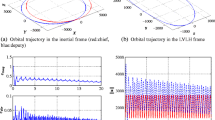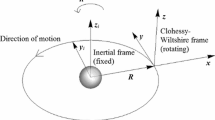Abstract
The solution of the initial relative orbit determination problem using angles-only measurements is important for orbital proximity operations, satellite inspection and servicing, and the identification of unknown space objects in similar orbits. In this paper, a preliminary relative orbit determination performance analysis is conducted utilizing the linearized relative orbital equations of motion in cylindrical coordinates. The relative orbital equations of motion in cylindrical coordinates are rigorously derived in several forms included the exact nonlinear two-body differential equations of motion, the linear-time-varying differential equations of motion for an elliptical orbit chief, and the linear-time-invariant differential equations of motion for a circular orbit chief. Using the nonlinear angles-only measurement equation in cylindrical coordinates, evidence of full-relative-state observability is found, contrary to the range observability problem exhibited in Cartesian coordinates. Based on these results, a geometric approach to assess initial relative orbit determination performance is formulated. To facilitate a better understanding of the problem, the focus is on the 2-dimensional initial orbit determination problem. The results clearly show the dependence of the relative orbit determination performance on the geometry of the relative motion and on the time-interval between observations. Analysis is conducted for leader-follower orbits and flyby orbits where the deputy passes directly above or below the chief.












Similar content being viewed by others
References
Gauss, C.F., Motus, T.: Theory of the motion of the heavenly bodies moving about the sun in conic sections. C.H. Davis Translation Little Brown, Boston (1857)
Curtis, H.D.: Orbital Mechanics for Engineering Students, ch. 7, pp. 391–420 Elsevier Ltd. (2010)
Crassidis, J., Junkins, J.: Optimal estimation of dynamics systems. CRC Pressd (2012)
Hill, G.W.: Researches in the lunar theory. Amer. J. Math. 1, 5–26 (1878)
Clohessy, W.H., Wiltshire, R.: Terminal guidance system for satellite rendezvous. J. Aero/Space Sci. 27(3), 653–658 (1960)
Woffinden, D.: Angles-only navigation for autonomous orbital rendezvous. PhD Thesis, Utah State University, Loganm, Utah (2008)
Yamanaka, K., Ankersen, F.: New state transition matrix for relative motion on an arbitrary elliptical orbit. J. Guid. control Dyn. 25(1), 60–66 (2002)
Carter, T.E.: State transition matrices for terminal rendezvous studies: brief survey and new example. J. Guid. Control Dyn. 21(1), 148–155 (1998)
Grzymisch, J., Fichter, W.: Analytic optimal observability maneuvers for in-orbit bearings-only rendezvous. J. Guid. Control Dyn. 37(5), 1658–1664 (2014)
Grzymisch, J., Fichter, W.: Observability criteria and unobservable maneuvers for in-orbit bearings-only navigation. J. Guid. Control Dyn. 37(4), 1250–1259 (2014)
Woffinden, D., Geller, D.: Observability criteria for angles-only navigation. IEEE Trans. Aerosp. Electron. Syst. 45(3), 1194–1208 (2009)
LeGrand, K.A., DeMars, K.J., Pernicka, H.J.: Bearings-only initial relative orbit determination. J. Guid. Control Dyn. 38(9), 1699–1713 (2015)
Geller, D.K., Klein, I.: Angles-only navigation state observability during orbital proximity operations. J. Guid Control Dyn. (2014). doi:10.2514/1.G000133
Gaisas, G., D’Amico, S., Ardeans, J.S.: Angles-only navigation to a noncooperative satellite using relative orbital elements. J. Guid. Control Dyn. 37(2), 439–451 (2014). doi:10.2514/1.61494
Alfriend, K., Vadali, R., Gurfil, P., How, J.: Spacecraft formation flying: Dynamics, control and navigation. Elsevier (2009)
De Bruijn, F., Gill, E., How, J.: Comparative analysis of cartesian and curvilinear clohessywiltshire equations. 22nd International Symposium on Space Flight Dynamics, Instituto Nacional de Pesquisas Espaciais (2011)
Kaufman, E., Lovell, T.A., Lee, T.: Nonlinear observability for relative orbit determination with angles-only measurements. J. Astronaut. Sci., 1–21 (2015)
Crassidis, J., Junkins, J.: Optimal Estimation of Dynamics Systems, ch. 2, p. 79 CRC Pressd (2012)
Leva, J.L.: Understanding GPS Principles and Applications, ch. 7, p. 267 Artech House (1996)
Author information
Authors and Affiliations
Corresponding author
Rights and permissions
About this article
Cite this article
Geller, D.K., Lovell, T.A. Angles-Only Initial Relative Orbit Determination Performance Analysis using Cylindrical Coordinates. J of Astronaut Sci 64, 72–96 (2017). https://doi.org/10.1007/s40295-016-0095-z
Published:
Issue Date:
DOI: https://doi.org/10.1007/s40295-016-0095-z




